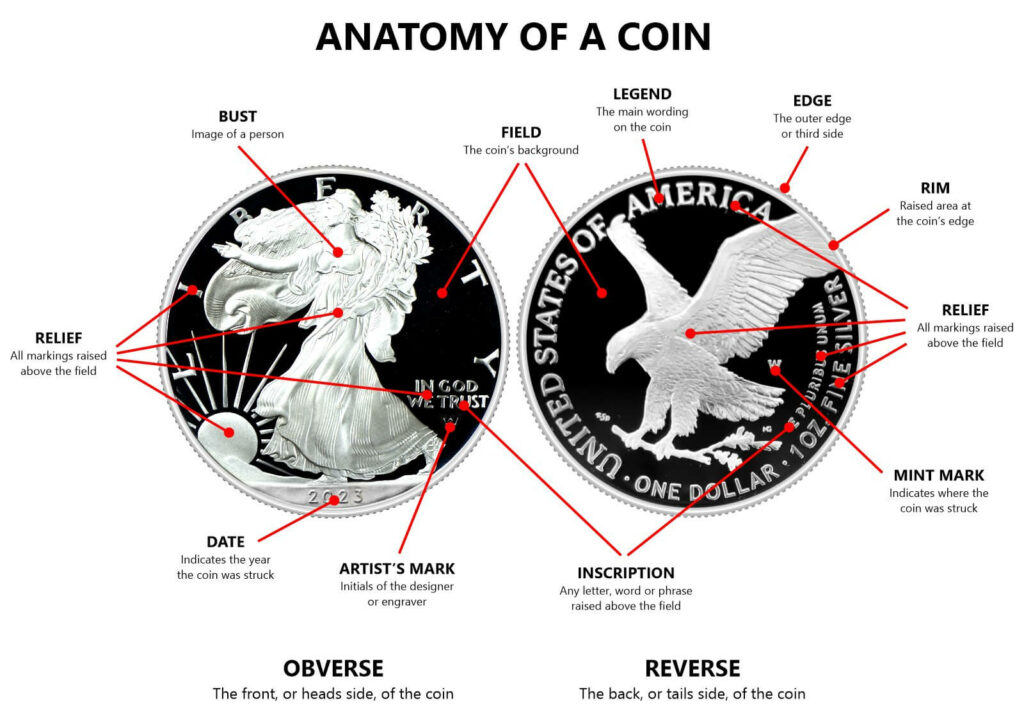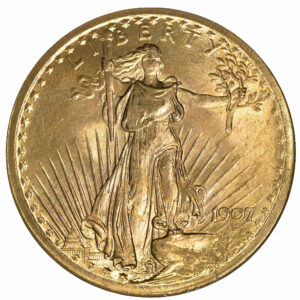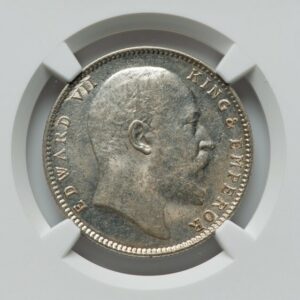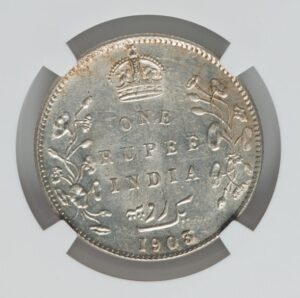
The Anatomy of a Coin: What to Know
Category: Determining Collectability
Coins are used extensively in our daily lives. They’re often passed from person to person, and we don’t usually take the time to look at the elements that work together to make the coin what it is.
As we step into the world of numismatics, however, coins become more than just a currency.
They are a canvas for history, art, and culture. And each distinct feature on a coin can bear a fascinating story that can captivate both experienced collectors and budding coin enthusiasts alike.
To better understand the story behind each coin, we can start by learning the anatomy of a coin—the different parts, what they’re called, and how they all come together.
The Sides of a Coin
You may have heard coin sides often referred to as either “heads” or “tails”. But in the numismatic community, you have to be familiar with the technical terms that collectors and investors use:
- Obverse: The front side (“heads”) of a coin. In American currency, the obverse is where you can typically find the national emblem or an effigy of a president, statesperson, or leader.
- Reverse: The back side (“tails”) of a coin. It usually bears the denomination, as well as a symbol or design representing the country or issuing authority, such as a well-known landmark.
For some collector coins, it may not be directly obvious which side is the obverse. Keep in mind that the terms are used as a matter of convention and not as strict rules for all coins.
The Anatomy of a Coin
Let's take a look at the main terms you’ll likely come across when exploring the anatomy of a coin.
There are some characteristics that one can expect to see on every coin, such as the denomination or inscription. Other features, however, such as the mint mark or designer’s initials, may not be present depending on the series or mint.

-
- Edge: The outer border of the coin, also known as the “third side” (not to be confused with the rim). Edges may be plain, decorated, lettered or reeded. Reeded and “serrated” are sometimes used interchangeably.
- Rim: The raised portion along the perimeter of a coin. This helps protect coins from excessive wear and makes them easier to stack.
- Legend: The lettering that runs across the field of a coin. They may be found on both the obverse and reverse. The term may also be used to refer to the year of issue, denomination, motto, and other design elements of a coin.
- Field: The field refers to the flat area of the coin’s obverse and reverse. It provides a background or backdrop for the central design, creating contrast and visual balance.
- Mint mark: A small letter or symbol used to identify where a coin was made. Current U.S. marks you can expect to find are P (Philadelphia), S (San Francisco), D (Denver), and W (West Point).
- Devices: The term is used for any objects or figures depicted on a coin’s surface, which can include the portrait, the denomination, inscriptions, and more.
- Motto: A phrase or slogan on a coin that’s meaningful to a particular country. It may be religious or political.
- Date/Year of issue: The numerals on a coin that represent the year it was minted. This may be placed at the top or bottom of the coin, and on either the obverse or reverse.
- Designer Initials: Usually two or more letters denoting the name of the designer of the coin. Not every coin bears the initials of its designer. Depending on the particular coin and its history, the initials may make a coin more valuable to collectors.

St. Gaudens $20 Gold Coin
(Obverse: Designer initials “AG” are visible under the year of issue.)
Relief and Incuse Designs in Coins
In addition to the parts of a coin, let’s explore the difference between relief and incuse designs. What do these terms mean and how do they differ when studying the anatomy of a coin?
- Relief: The main characteristic of a relief design is it’s raised above the coin’s surface (opposite of “incuse”). The devices stand out in a three-dimensional manner, giving the coin a more prominent and tactile appearance.
- Incuse: The design of a coin that has been impressed below the coin’s surface is called an incuse. This creates a depressed or sunken appearance, which is an uncommon characteristic in most coins.
Many, if not most, of the coins you’ll encounter in the numismatic world have a relief design. Some coins, however, will have a combination of both relief and incuse, such as the 1903 Indian Rupee.


1903B India Incuse Mintmark Rupee MS
(Obverse and Reverse)
Incuse coins are generally considered rare and unique, and can also be more expensive than standard relief coins.
Putting It All Together
For numismatists, every aspect of the coin is important. Knowing the anatomy of a coin and recognizing the specific characteristics and design elements can help us identify counterfeits and protect us from purchasing fake coins. We also learn how the different parts come together to create a unique tapestry, a narrative that offers a glimpse into the past and the events that shaped our world today.
As a coin collector, it’s easier to make informed decisions when you’re familiar with the terminology. So the next time you hold a coin in your hand, especially a particularly unique one, you may want to take a closer look. From the mint marks, effigies, and legends, to the reeds and inscriptions—learning the anatomy of a coin can help us appreciate that they are more than just a currency, but a bridge between the past, the present, and the future.


